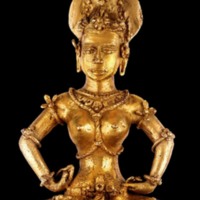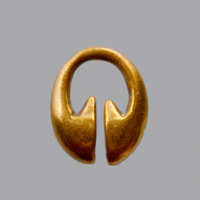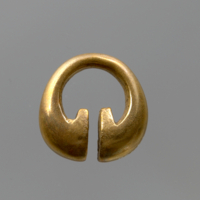Gold Figure
Text
Schadenberg (in Mayer and Schadenberg 1890) mentions that little anthropomorphic figurines in gold were made in the rancheria of Sayuc in Lepanto (Suyoc valley, northern Benguet), an area that still produces gold today. Some years ago this long forgotten example of such an exceedingly rare figurine surfaced in the safe at the Museum of Ethnology in Vienna, where it had been kept for safekeeping since its arrival over 100 years ago. According to the informant Henry Beyer all but two gold figurines remaining in the Sayuc area were melted down during the 1950s when the price of gold soared. Unfortunately, knowledge about the exact significance of these figurines has been lost, but the pronounced erect penis insinuates association with fertility, which symbolizes wealth in general. Schadenberg himself refers to the item as a "house deity," and mentions that it was difficult to acquire. The fact that the figure is unclad yet wearing a rather large basketry, leaf, or gourd headgear (see also the figure MVW 30915 collected by Schadenberg) may be significant, and there is no doubt the figurine was associated in some manner with a ritual, most probably to induce good luck and wealth for the family owning it. The figurine is rather crudely manufactured by lost wax casting, and stylistically it is reminiscent of wooden carvings from the Kalanguya / Kankanay area. It is quite realistically rendered in comparison with - for example - tinagtagu (anthropomorphic) bronze cast anito (ancestor) pipes from the very same area. The position of the figure is most unusual in that its left hand (instead of elbow) rests on the left knee, while the right hand holds a staff - probably depicting the "silver" headed cane traditionally given by the Spanish governor to representative head men as insignia of authority. (ea)
Footnote: See also Schadenberg's original artefact note: "I here present a house deity of Igorroten from Bengned [Banguet, ea], cast in solid gold and quite rare, since difficult to acquire […]" -[German original: "Ich lege hier einen Hausgott der Igorroten von Bengned vor, derselbe ist massiv aus Gold gegossen und recht selten, da er schwer zu acquiriren ist (…)"] (Schadenberg 1884: 110).
Share this



